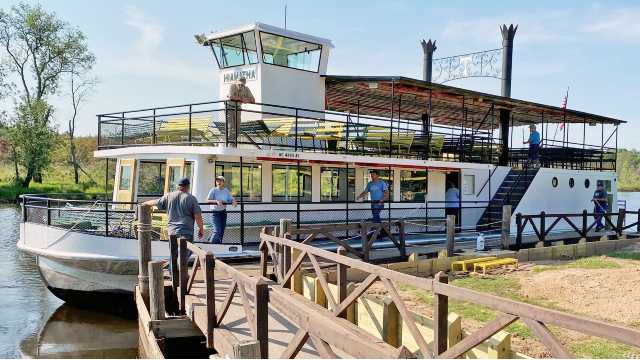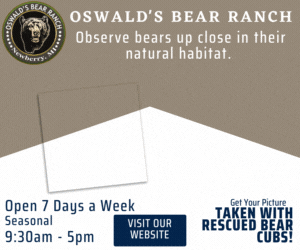By Sterling McGinn
The iconic Toonerville Trolley and Riverboat Tour is wrapping up its 96th season of taking visitors and locals down the Tahquamenon River to the Upper Tahquamenon Falls. But its 97th season is in question. Visitors booking a seat on the famous trip may notice a “Buy Me” link on the business’s website. Owners Kris and Dixie Stewart, who have operated the business for 42 years, are ready to retire.
The Stewarts listed the business for sale in 2022.
“Our plan is to hopefully get a commitment from a buyer and turn the business over to them in 2024,” said Dixie Stewart. “If we do not have a buyer, we will not be running in 2024.”
The Stewarts’ last scheduled trip for the season is Saturday, October 7.
Headquartered at Soo Junction, a historic railroad stop on the mainline, the Toonerville Trolley is the longest 24-inch narrow-gauge railroad in the United States. The excursion transports guests 5 ½ miles through the thick wilderness to Hunter’s Mill, where visitors board the riverboat Hiawatha.
Passengers of the Hiawatha travel 21 miles down the historic river with Captain Kris Stewart’s voice on the intercom pointing out landmarks along the way.
The boat lands above the brink of the Upper Falls, where it is docked for 1 ¼ hours to allow for passengers to hike the trail to the falls. The trip then proceeds back to Hunter’s Mill, where visitors are transported to Soo Junction.
The Upper Tahquamenon Falls is now a state park visited by more than a half million people each year. But prior to the early 1950, the only way to see the falls was by river travel.
Interested locals and visitors seeking a rare glimpse of the mighty Tahquamenon Falls often accompanied state game warden Joe Beach on his 14-hour daily patrols. He was very familiar with the twists and turns of the river after patrolling the Tahquamenon daily with the state boat.
The river trip tour began in 1927 when Joe Beach, a state game warden stationed at the McNearney Farm, opened a business to allow people to see the river and the falls.
Beach shortened the 14-hour round trip after negotiating the use of the old Hunter and Love Railroad from local lumberman Robert Hunter, who later became a partner in Beach’s business. Hunter is the great-grandfather of Kris Stewart.
The negotiation enabled visitors to drive to Soo Junction, ride a train to the river and board the boat, significantly shortening the trip. Hunter had owned the railroad and the former sawmill at Hunter’s Mill.
The first river boat was the Betty B. The first Toonerville Trolley was a Model T Ford pickup fitted with train wheels.
The trip grew popular, and a larger boat, the Tahquamenon, was christened in 1938. The 400-capacity boat was built by Ed Trombley and was complete with a dance floor and jukebox.
The rail was converted to narrow-gauge in 1933, and today two Plymouth five-ton diesel locomotives make up the Toonerville Trolley. A separate train trip is offered for those who don’t want to ride on the river.
A second boat, the Paul Bunyan, was added to the fleet in 1940. The two boats working in tandem brought more than 700 people to the falls a day. Joe Beach piloted the Paul Bunyan, and Ed Trombley ran the Tahquamenon.
Even with the opening of the Tahquamenon Falls State Park, and an actual road leading to the falls area, the tour was and is a popular attraction.
After Joe Beach’s untimely death in 1947, the business was taken over by his son Richard J. (R. J.) Beach. He continued to operate the tour until 1981, when it was sold to Hugh Stewart and family.
During R. J.’s tenure, the current boat, the Hiawatha, replaced the old Tahquamenon. The vessel was constructed by T. D. Vinette in 1963 with a capacity of 250 passengers. The new boat reduced travel time to a 6 ½ hour round trip. The Hiawatha is the only boat used today.
Ready to pass the torch to the next owners, the Stewarts have set the sale price at $500,000. They are open to offers from serious buyers. The buyer would get the business and equipment and a low-cost lease for the land would be negotiated as part of the business’s sale. The Stewarts will maintain ownership of the land.
“We would stay on long enough to get them trained on everything,” Dixie Stewart said. “Kris wants to be retired, but I am willing to stay on a few more years if they want me to.”
The equipment will be sold in parcels if a buyer is not found.












